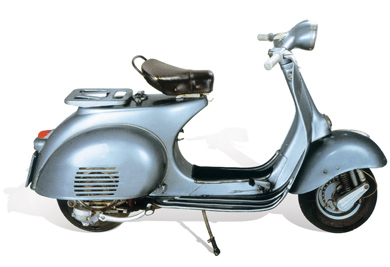very good
4.7 / 5
Shipping today with order in 20 min
Postage free from 99€ (DE)
High customer satisfaction
Shipping today with order in 20 min

To close the gap between the 125cc and the Grand Sport models, Piaggio added the 150cc models with the frame abbreviation "VBA" to the VNA models in 1959. As already anticipated with the VNA, the wideframe with the flap in the step-through is no longer used here either, but the narrower frame, which we now refer to as the "largeframe". The leg shield is flanged with an aluminum strip to protect it from scratches, and for the first time a Piaggio plastic square is used. The scooter is supplied with a single saddle and luggage rack as standard. The speedometer had a white dial and the scallop shape that would appear many times later. The trim strips disappear in the step-through and a rubber floor mat finds its way onto the step-through. Another innovation is the engine capacity indication on the leg shield.
The truly pioneering and groundbreaking innovation, however, is clearly a technical one. The completely redesigned engine features rotary valve control for the first time. For this purpose, one of the crank webs was provided with a cut-out that allowed the fuel mixture to enter the crankcase according to the desired intake timing. During the rest of the time, the crank web closes the inlet located in the engine block. This is an extremely reliable and low-maintenance principle that also ensures significantly improved lubrication of the crank mechanism. The lower connecting rod bearing is located directly in the cooling and lubricating fresh gas flow. It is still a three-speed engine. On the carburetor side, an SI 20/17 carburetor from the automotive sector is installed, which draws in the air from the frame via a rubber intake bellows. A principle that has been retained right up to the current PX series. The Vespa VBA1T is supplied with 8-inch tyres in light blue metallic (MaxMeyer code 15067).
Frame numbers by year of manufacture:
1958: VBA1T 1001-16515
1959: VBA1T 16516-88519
1960: VBA1T 88520-125040



